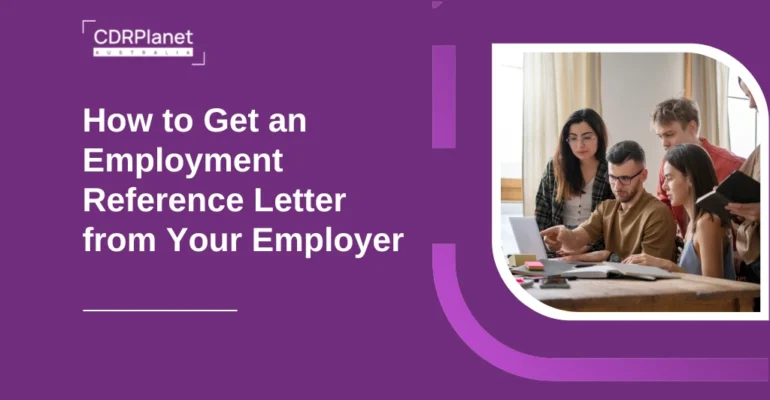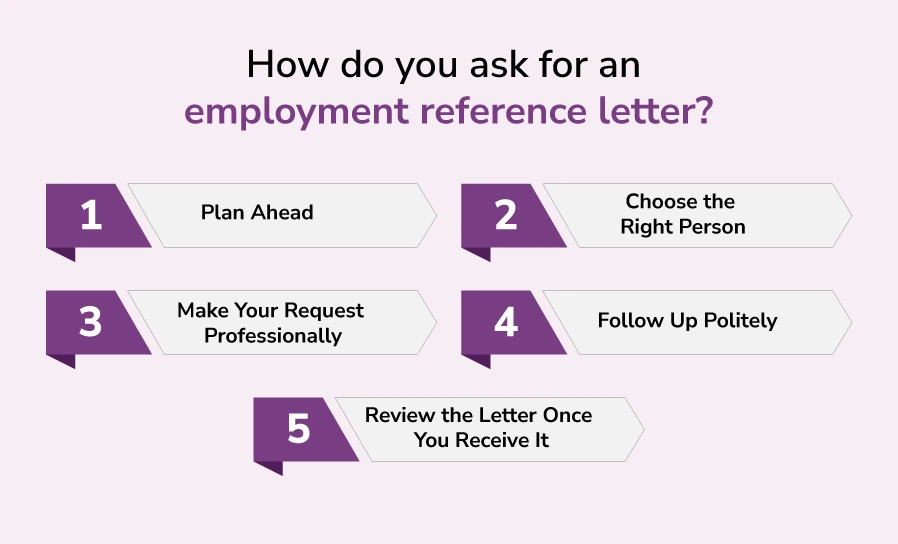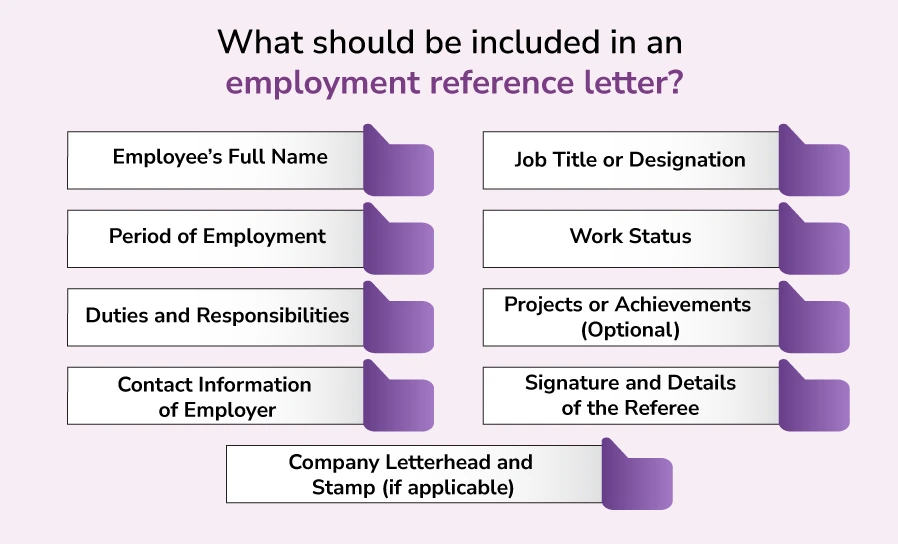How to Get an Employment Reference Letter from Your Employer

How to Get an Employment Reference Letter from Your Employer
The employment reference letter is not just a formality but a crucial tool for your professional growth and migration aspirations. It plays a pivotal role when you are looking to transition to a new job, secure a skilled migration to Australia, or meet licensing requirements. Its significance cannot be overstated.
This comprehensive guide provides information on obtaining an employment reference letter from your employer. It provides a step-by-step approach, from identifying the right person to contact to understanding the necessary components, and offers additional advice for meeting Australian immigration letter requirements. With this guide, you can navigate the process with confidence.
What is an employment reference letter?
Employment reference letters serve as official verification documents that businesses provide through job reference letters, work reference letters, or experience letters to present employment details and professional conduct of their former or current staff members. The main goal of this reference document is to verify workplace experience along with duties performed by employees while confirming their abilities and professional behaviour. This document validates all third-party claims made by candidates while playing multiple important roles within professional and legal systems.
The document emerges from the company’s formal stationery and features a signature from someone in senior authority, such as an HR manager, supervisor, or director. When applying for skilled migration or a visa or licence, the relevant assessing authority or government department specifies requirements that a professional reference letter must fulfil.
How do you ask for an employment reference letter?

A proper request for an employment reference letter should follow these steps.
Learning to request an employment reference letter might feel challenging to beginners who do not understand proper procedures. However, the process becomes easier when you prepare properly while showing respect. These factors help the writer generate a stronger and more truthful letter. The following breakdown demonstrates the proper method of making your request.
Step 1: Plan Ahead
The decision to ask for a reference letter demands that you establish exactly what purpose the letter serves in advance. The message content, together with the letter, will differ substantially based on what you want from the letter. For example:
The letter should demonstrate job performance with highlights of achievements and skills when seeking a job application.
A reference letter intended for licencing or chartered status explanations needs to concentrate on technical competencies and include professional development elements.
The Employment Reference Letter for Australian Immigration needs to follow specific guidelines set by Engineers Australia, ACS, and VETASSESS for Australian skilled migration purposes.
Step 2: Choose the Right Person
The person who creates your reference letter determines its success rate. Always choose someone:
In a senior position (e.g., team leader, department head, HR manager).
The person you select must understand your job duties and performance because they have observed your work closely.
The employee who continues working at the company should verify, especially during Canadian immigration checks, as needed.
When writing employment reference letters for Australian immigration, two essential conditions should apply:
An official company role privileges this person to provide valid references.
The provided contact details, together with the official designation, can be validated through company records or online databases.
They comprehend the serious nature of this document because it may be reviewed by immigration authorities and assessment bodies.
Make sure to obtain an employment reference from distinct referees who will verify your roles at every company where you have worked.
Step 3: Make Your Request Professionally
Your approach to asking your referee for an employment reference letter must be both professional and respectful. Your approach depends on your relationship status, but the method remains either a personal email or an exit interview.
The assessment process requires official guidelines released by Engineers Australia or ACS and any available sample documents, which should be included in this materials section.
You need to give your referees all the essential details about yourself, including your name, job title, employment dates, responsibilities and achievements, full-time or part-time status, reporting manager identity and job position, and employee identification number. To ensure the letter content matches precisely, add the ANZSCO code being applied to the job duty specifications for the skilled migration application.
Step 4: Follow Up Politely
A delayed response does not signify unprofessionalism, so you can gently reach out again after waiting a few days. Avoid sounding demanding. Show appreciation and then discuss the submission deadline.
Step 5: Review the Letter Once You Receive It
The details in your employment reference letter need thorough examination after your referee provides it, and you can confirm their accuracy against the application specifications. Examine the document to ensure the dates of employment, job position, and responsibilities provided exactly match what appears in your official records.
The employment reference letter needs to display proper company letterhead and contain all the referee’s complete information, including position and signature, with contact details. An Australian immigration letter needs to match your target ANZSCO code by featuring duties that fit within the assessment requirements set by relevant authorities.
What should be included in an employment reference letter?

An employment reference letter should include the following information:
1. Employee’s Full Name
Employees should provide their complete official name for accurate recordkeeping purposes.
2. Job Title or Designation
All job titles held by an employee during employment must correspond to their real work responsibilities and represent the titles that the employer assigned.
3. Period of Employment
Migrating personnel must include particular dates expressing the exact limits by day, month, and year. A statement indicating ongoing employment days should read “to present.”
4. Work Status
The work status of full-time, part-time, or contractual must be specified, together with average weekly work hours that matter for migration reasons.
5. Duties and Responsibilities
The document lists the specific tasks that the employee achieved. This section holds exceptional importance for matching employee duties to established occupational standards, which use ANZSCO codes for Australian authorities.
6. Projects or Achievements (Optional)
Adding relevant achievements strengthens the reference document because it demonstrates how the employee shaped their roles.
7. Contact Information of Employer
The document requires both a work address and a work phone, along with an email and website (if applicable) to validate information.
8. Signature and Details of the Referee
The letter needs to display the identification information of the person providing the signature. The verifier needs to hold a position that enables them to confirm the information.
9. Company Letterhead and Stamp (if applicable)
The professional document should display the official company header on the printing platform. Using a company stamp alongside visa processing and migration work helps establish official authenticity.
Why Is an Employment Reference Letter Important?
The reference letter functions as more than just a process requirement since it serves multiple vital purposes.
- Job applications require employers to use these references both for experience verification and competence assessment of candidates.
- When applying for skilled migration visas, the authorities, such as Engineers Australia and ACS (Australian Computer Society), together with VETASSESS, ask for thorough reference letters for visa qualification assessments.
- The visa and immigration applications of numerous countries require documentation of professional experience for verification.
- Professional licencing or certification programmes need reference letters as an evaluation tool to check if candidates meet established experience requirements.
- Reference letters create a solid foundation for both career changes between different professions and high-level executive applications.
Conclusion
An employment reference letter functions as more than paperwork because it showcases the entire professional story you have travelled. This document both confirms your field skills and strengthens your professional reputation while serving as a crucial asset to enter exciting new prospects, no matter if you seek a career opening or graduate programme or wish to move internationally.
The combination of strategic application and proper timing of employment reference letters plays a substantial role in enhancing your professional image. This document offers long-lasting advantages to both the seeker and the employer, as well as students and migrants who use it appropriately.
FAQs
1. How do you get an employment reference letter?
To get an employer reference letter, politely request it from your supervisor or HR, explain its purpose, and provide necessary details and a sample format.
2. How long does it take to write a reference letter?
It usually takes 2 to 5 business days to write a reference letter.
3. What is a reference letter?
A reference letter is a formal document written by an employer or supervisor that verifies your job title, employment period, duties, and work performance.